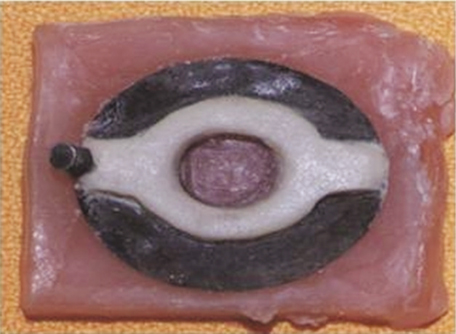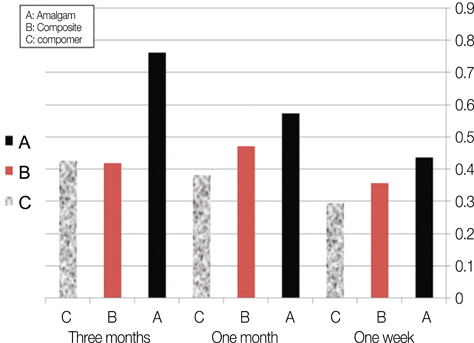J Adv Prosthodont.
2011 Dec;3(4):186-189. 10.4047/jap.2011.3.4.186.
The effect of thermocycling on the bonding of different restorative materials to access opening through porcelain fused to metal restorations
- Affiliations
-
- 1Department of Prosthodontics, College of Dentistry, King Khalid University, Abha, Saudi Arabia.
- 2Dental Public Health, Year II , Kings College London, UK.
- 3Department of Prosthodontics, Pacific dental college and Hospital, Udaipur, India. aporwal2000@gmail.com
- KMID: 2054752
- DOI: http://doi.org/10.4047/jap.2011.3.4.186
Abstract
- PURPOSE
Porcelain fused to metal (PFM) crowns provide the best treatment option for teeth that have a large or defective restoration. More than 20% of teeth with PFM crowns or bridges require non-surgical root canal treatment (NSRCT). This may be due to the effect of restorative procedures and the possible leakage of bacteria and or their by-products, which leads to the demise of the tooth pulp. Thus, this study was planned to compare the ability of the restorative materials to seal perforated PFM specimens.
MATERIALS AND METHODS
The study evaluates the ability of amalgam, composite or compomer restorative materials to close perforated PFM specimen's in-vitro. Ninety PFM specimens were constructed using Ni-Cr alloys and feldspathic porcelain, and then they were divided into 3 groups: amalgam (A), composite + Exite adhesive bond (B) and compomer + Syntac adhesive bond (C). All the PFM samples were embedded in an acrylic block to provide complete sealing of the hole from the bottom side. After the aging period, each group was further divided into 3 equal subgroups according to the thermocycling period (one week for 70 cycles, one month for 300 cycles and three months for 900 cycles). Each subgroup was put into containers containing dye (Pelikan INK), one maintained at 5degrees C and the other at 55degrees C, each cycle for 30 sec time. The data obtained was analyzed by SPSS, 2006 using one way ANOVA test and student t-test and significant difference level at (P<.01).
RESULTS
The depth of dye penetration was measured at the interfaces of PFM and filling materials using Co-ordinate Vernier Microscope. The lowest levels of the dye penetration for the three groups, as well as subgroups were during the first week. The values of dye leakage had significantly increased by time intervals in subgroups A and C.
CONCLUSION
It was seen that amalgam showed higher leakage than composite while compomer showed the lowest level of leakage.
MeSH Terms
Figure
Reference
-
1. Trautmann G, Gutmann JL, Nunn ME, Witherspoon DE, Shulman JD. Restoring teeth that are endodontically treated through existing crowns. Part II: Survey of restorative materials commonly used. Quintessence Int. 2000. 31:719–728.2. Kappert HF. Modern metal ceramic system. Dent News. 1998. 11:29–40.3. Hickel R, Dasch W, Janda R, Tyas M, Anusavice K. New direct restorative materials. FDI Commission Project. Int Dent J. 1998. 48:3–16.4. Haller B. Recent developments in dentin bonding. Am J Dent. 2000. 13:44–50.5. Puckett AD, Fitchie JG, Inman CC, Dellinger TM, Karns L. Microlekage of a compomer compared to conventional and hybrid ionomer. Quintessence Int. 2001. 32:49–54.6. Güler AU, Yilmaz F, Ural C, Güler E. Evaluation of 24-hour shear bond strength of resin composite to porcelain according to surface treatment. Int J Prosthodont. 2005. 18:156–160.7. Trautmann G, Gutmann JL, Nunn ME, Witherspoon DE, Berry CW, Romero GG. Restoring teeth endodontically treated through existing crowns. Part IV. Material usage and prevention of dye leakage. Quintessence Int. 2001. 32:33–41.8. Hakimeh S, Vaidyanathan J, Houpt ML, Vaidyanathan TK, Von Hagen S. Microleakage of compomer class V restorations: effect of load cycling, thermal cycling, and cavity shape differences. J Prosthet Dent. 2000. 83:194–203.9. Ozer F, Unlü N, Oztürk B, Sengun A. Amalgam repair: evaluation of bond strength and microleakage. Oper Dent. 2002. 27:199–203.10. Alavi AA, Kianimanesh N. Microleakage of direct and indirect composite restorations with three dentin bonding agents. Oper Dent. 2002. 27:19–24.11. Irie M, Suzuki K. Marginal seal of resin-modified glass ionomers and compomers: effect of delaying polishing procedure after one-day storage. Oper Dent. 2000. 25:488–496.12. Ozcan M, Vallittu PK. Effect of surface conditioning methods on the bond strength of luting cement to ceramics. Dent Mater. 2003. 19:725–731.13. Briseño Marroquin B, Kremers L, Willershausen-Zönchen B, Mücke A. Microleakage of gold casting repairs with different materials as quantified by a helium gas system. Oper Dent. 1995. 20:197–203.14. Trautmann G, Gutmann JL, Nunn ME, Witherspoon DE, Berry CW, Romero GG. Restoring teeth endodontically treated through existing crowns. Part III. Material usage and prevention of bacterial leakage. Quintessence Int. 2001. 32:27–32.15. Craig RG. Restorative dental materials (10th ed). 1997. St. Louis: Mosby.16. Irie M, Suzuki K. Effects of delayed polishing on gap formation of cervical restorations. Oper Dent. 2002. 27:59–65.17. Grobler SR, Rossouw RJ, van Wyk Kotze TJ. In vitro, relative microleakage of five restorative systems. Int Dent J. 1999. 49:47–52.18. Leinfelder KF. Is it possible to control the directional shrinkage of resin-based composites? J Am Dent Assoc. 2001. 132:782–783.
- Full Text Links
- Actions
-
Cited
- CITED
-
- Close
- Share
- Similar articles
-
- Comparative study in marginal fit of a pressed ceramic and feldspathic porcelain fused to metal restoration
- A comparison of fracture strengths of porcelain-fused-to-titanium crown among titanium surface coating treatments
- Bond-strength of several metal-meramic alloys and meneered-porcelain
- A Study On The Color Stability Of Porcelain For Porcelain Fused To Metal Crown
- A study on the color stability of porcelain repair resins



